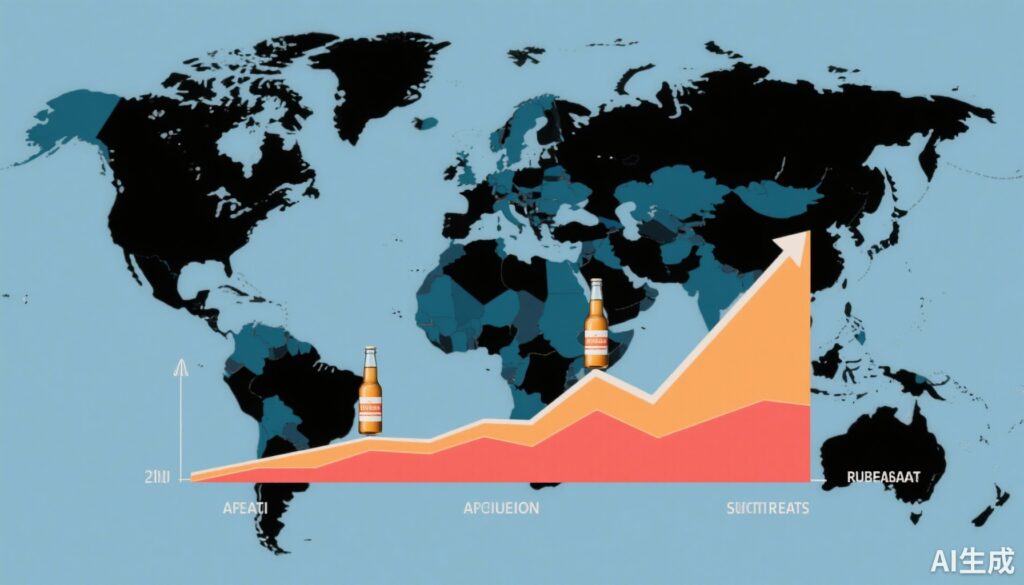Highlight
This meta-analysis consolidates evidence that a 1-liter increase in alcohol consumption per capita correlates with a 3.59% rise in population suicide mortality rates. Notably, this association does not differ by sex, emphasizing alcohol consumption as a universal population-level contributor to suicide risk. These findings suggest that public health strategies targeting alcohol reduction could be instrumental in suicide prevention.
Study Background and Disease Burden
Suicide is a critical global public health challenge, accounting for over 700,000 deaths annually worldwide. Alcohol use at an individual level is well-documented as an important modifiable risk factor that can increase suicidal ideation and behavior through mechanisms such as impulsivity, depression, and neurobiological alterations. However, the translation of these individual-level risk factors into population-level effects is less well understood. Alcohol Consumption Per Capita (APC) is a metric commonly used to assess total alcohol intake at the population level and monitor progress in reducing harmful alcohol use internationally. Establishing a population-level association between APC and suicide mortality could support alcohol control policies as important components of comprehensive suicide prevention programs and help allocate resources effectively.
Study Design
This systematic review and meta-analysis synthesized evidence from original quantitative studies that examined the association between APC and suicide mortality, covering all relevant articles published up to February 24, 2025. Data sources included Embase, Medline, PsycINFO, and Web of Science. Eligible studies employed longitudinal observational, cross-sectional ecological, or pre-post designs, and provided quantitative measures of association. After screening 304 records, 13 studies met inclusion criteria and were included in the meta-analysis. The Risk of Bias in Nonrandomized Studies of Exposure tool was used to assess potential bias, and evidence quality was evaluated through the Grading of Recommendations, Assessment, Development, and Evaluations (GRADE) framework. A random-effects meta-analysis was conducted to estimate the pooled effect of APC on suicide mortality. Additionally, random-effects meta-regression was applied to investigate potential sex differences in the association.
Key Findings
The meta-analysis revealed that every 1-liter increase in alcohol consumption per capita was associated with a 3.59% increase in the suicide mortality rate (95% confidence interval [CI], 2.38% to 4.79%). This finding indicates a statistically significant and clinically relevant relationship at the population level. Importantly, the analysis did not find evidence supporting a sex difference in the strength of the association, implying that alcohol consumption contributes similarly to suicide risk among men and women when assessed at the population scale. These results persisted across different study designs and geographic regions, suggesting generalizability.
A summary table of included studies highlights methodological approaches and effect sizes, demonstrating consistency despite heterogeneity in regional contexts and study populations. The absence of sex differences contrasts somewhat with individual-level data where alcohol-related suicide risk may vary by sex, possibly reflecting population-level mediators such as social or cultural factors influencing consumption patterns and suicide mortality differently than at the individual level.
Expert Commentary
These findings underscore the importance of targeting alcohol consumption reduction as part of multifaceted suicide prevention strategies. By confirming a dose-response relationship between APC and suicide mortality, the study validates international policy frameworks that advocate reducing harmful alcohol use to improve mental health outcomes. Mechanistically, alcohol may exacerbate psychiatric symptoms, impair judgment, and increase impulsivity, thereby elevating suicide risk.
Study limitations include potential ecological fallacy inherent in population-level analyses and residual confounding from unmeasured sociocultural factors. The included studies also varied in adjustment for confounders, possibly influencing effect estimates. Nonetheless, the application of rigorous risk of bias and evidence quality assessments strengthens confidence in the conclusions. Future research should explore longitudinal dynamics and investigate intervention impacts on APC and suicide concurrently.
Conclusion
This comprehensive meta-analysis establishes a clear quantitative relationship linking population-level alcohol consumption with increased suicide mortality rates. The uniformity of this association across sexes highlights alcohol consumption as a critical, modifiable factor in suicide risk that transcends demographic groups. Policymakers and healthcare providers should prioritize alcohol control measures within broader suicide prevention frameworks to mitigate this public health burden. Implementing strategies such as taxation, advertising restrictions, and treatment access for alcohol use disorders may result in measurable reductions in suicide mortality. Continued surveillance of APC alongside suicide trends will be essential for monitoring and optimizing prevention efforts globally.
References
Guo K, Jiang H, Shield KD, Spithoff S, Lange S. Alcohol Consumption Per Capita and Suicide: A Meta-Analysis. JAMA Netw Open. 2025 Sep 2;8(9):e2533129. doi: 10.1001/jamanetworkopen.2025.33129. PMID: 40982277.



